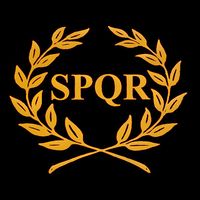Gens
(corrected reference link) |
|||
| Line 1: | Line 1: | ||
{{LanguageBar|Gens}} | {{LanguageBar|Gens}} | ||
| + | |||
| + | A '''''gens''''' is a group of families sharing a common ''[[nomen]]'': for example, [[Publius Cornelius Scipio Africanus|P. '''Cornelius''' Scipio]], [[Lucius Cornelius Sulla Felix|L. '''Cornelius''' Sulla]], and [[Publius Cornelius Dolabella|P. '''Cornelius''' Dolabella]] were all '''Cornelii''', or members of the '''''gens''''' '''Cornelia'''. | ||
Early social organization in central Italy was centered around the ''[[gens]]'', (clan), an "aristocratic lineage or group of lineages and some of their lesser followers and dependents"<ref name="village">Boatwright, M., Gargola, D., Talbert, R. (2004), "The Romans From Village to Empire", Oxford University Press</ref>. Inscriptions from the 7th century BCE show names consisting by that date of ''praenomen'' (identifies the individual) and ''nomen'' (identifies the ''gens'')<ref name="village"/>. | Early social organization in central Italy was centered around the ''[[gens]]'', (clan), an "aristocratic lineage or group of lineages and some of their lesser followers and dependents"<ref name="village">Boatwright, M., Gargola, D., Talbert, R. (2004), "The Romans From Village to Empire", Oxford University Press</ref>. Inscriptions from the 7th century BCE show names consisting by that date of ''praenomen'' (identifies the individual) and ''nomen'' (identifies the ''gens'')<ref name="village"/>. | ||
| + | |||
| + | Membership of a ''gens'' is hereditary: a Roman child is in the ''gens'' of his or her father. Some ancient ''gentes'' claimed that all their members were descended from a common ancestor, but this was perhaps never true; in any case it was not true by the middle of the ancient republic. | ||
| + | |||
| + | Nonetheless, in ancient times many noble ''gentes'' maintained close internal ties of kinship and support, and members of the same ''gens'' were often political allies. Many ''gentes'' also had shared religious traditions (''sacra gentilicia''), and it was socially unacceptable for members of the same ''gens'' to marry. | ||
Revision as of 18:19, 12 November 2012
Home| Latíné | Deutsch | Español | Français | Italiano | Magyar | Português | Română | Русский | English
A gens is a group of families sharing a common nomen: for example, P. Cornelius Scipio, L. Cornelius Sulla, and P. Cornelius Dolabella were all Cornelii, or members of the gens Cornelia.
Early social organization in central Italy was centered around the gens, (clan), an "aristocratic lineage or group of lineages and some of their lesser followers and dependents"[1]. Inscriptions from the 7th century BCE show names consisting by that date of praenomen (identifies the individual) and nomen (identifies the gens)[1].
Membership of a gens is hereditary: a Roman child is in the gens of his or her father. Some ancient gentes claimed that all their members were descended from a common ancestor, but this was perhaps never true; in any case it was not true by the middle of the ancient republic.
Nonetheless, in ancient times many noble gentes maintained close internal ties of kinship and support, and members of the same gens were often political allies. Many gentes also had shared religious traditions (sacra gentilicia), and it was socially unacceptable for members of the same gens to marry.
